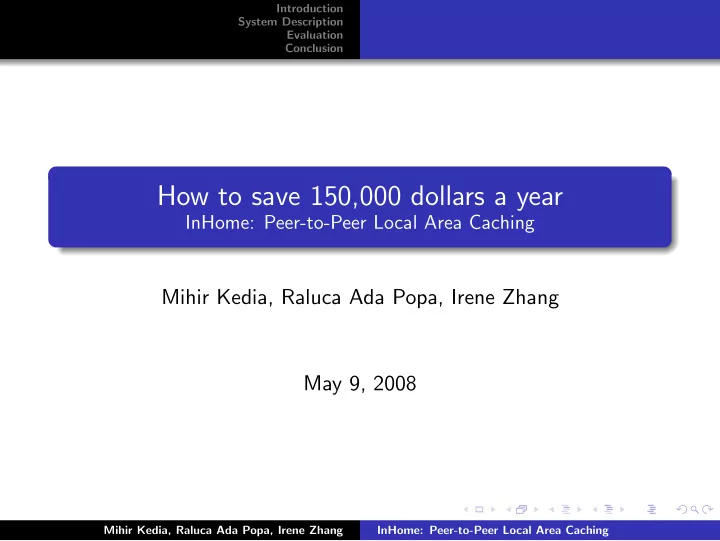

Introduction System Description Evaluation Conclusion How to save 150,000 dollars a year InHome: Peer-to-Peer Local Area Caching Mihir Kedia, Raluca Ada Popa, Irene Zhang May 9, 2008 Mihir Kedia, Raluca Ada Popa, Irene Zhang InHome: Peer-to-Peer Local Area Caching
Introduction System Description Motivation Evaluation Objective Conclusion Motivation Wide-area bandwidth is becoming increasingly scarce Bandwidth-hungry applications like Youtube are outpacing infrastructure upgrades Local-area bandwidth is cheap and often unused Much of the data traversing outgoing links is redundant 25-40% of web requests made within a given organization are duplicates of previous requests. Mihir Kedia, Raluca Ada Popa, Irene Zhang InHome: Peer-to-Peer Local Area Caching
Introduction System Description Motivation Evaluation Objective Conclusion Objective Reduce external bandwidth usage by sharing data among peers inside an organization. System requirements: Clients should not see a significant increase in latency Clients should not store data they are not interested in System should be customizable for organization sizes System should not require new hardware or maintenance Mihir Kedia, Raluca Ada Popa, Irene Zhang InHome: Peer-to-Peer Local Area Caching
Introduction System Overview System Description Example Usage Evaluation Search Algorithms Conclusion Data-Oriented Chord System Overview InHome is implemented as a peer-to-peer network that operates like a distributed cache Clients run a background daemon that automatically syncs metadata from InHome-aware applications Application-specific plugins query the InHome network for data before falling back to the origin server Consistent hashing is used for fast object lookup Interface: put(name, data) data = get(name) Mihir Kedia, Raluca Ada Popa, Irene Zhang InHome: Peer-to-Peer Local Area Caching
Introduction System Overview System Description Example Usage Evaluation Search Algorithms Conclusion Data-Oriented Chord Example Usage: Web Caching For each HTTP request: 1 Mozilla plugin queries the InHome client for the URL 2 InHome client hashes the URL into a 160-bit object ID 3 InHome client searches the InHome peers for the object ID 4 If the search succeeds, Mozilla plugin will return cached data after checking the TTL 5 If the search fails or times out, the Mozilla plugin tells Mozilla to fetch the page from the origin server in the normal way 6 Mozilla plugin registers the new data with the InHome client by inserting the data with the URL Mihir Kedia, Raluca Ada Popa, Irene Zhang InHome: Peer-to-Peer Local Area Caching
Introduction System Overview System Description Example Usage Evaluation Search Algorithms Conclusion Data-Oriented Chord Search Algorithms Basic Consistent Hashing Data-oriented Chord Full membership Partial Membership One-hop lookup log( n ) hop lookup Metadata maintenance No metadata No fate sharing Fate sharing Mihir Kedia, Raluca Ada Popa, Irene Zhang InHome: Peer-to-Peer Local Area Caching
Introduction System Overview System Description Example Usage Evaluation Search Algorithms Conclusion Data-Oriented Chord Data-Oriented Chord Mihir Kedia, Raluca Ada Popa, Irene Zhang InHome: Peer-to-Peer Local Area Caching
Introduction System Overview System Description Example Usage Evaluation Search Algorithms Conclusion Data-Oriented Chord Data-Oriented Chord Mihir Kedia, Raluca Ada Popa, Irene Zhang InHome: Peer-to-Peer Local Area Caching
Introduction System Description Search Algorithm Comparison Evaluation Bandwidth Savings Conclusion Performance Comparison Average Number of Hops Per Search 8 Data-oriented Chord with Partial Membership Consistent Hashing with Full Membership 7 6 5 Number of hops 4 3 2 1 0 0 500 1000 1500 2000 Number of nodes Mihir Kedia, Raluca Ada Popa, Irene Zhang InHome: Peer-to-Peer Local Area Caching
Introduction System Description Search Algorithm Comparison Evaluation Bandwidth Savings Conclusion Bandwidth Comparison Average Number of Messages Sent and Received 2500 Data-oriented Chord with Partial Membership Consistent Hashing with Full Membership 2000 Number of messages 1500 1000 500 0 0 500 1000 1500 2000 Number of nodes Mihir Kedia, Raluca Ada Popa, Irene Zhang InHome: Peer-to-Peer Local Area Caching
Introduction System Description Search Algorithm Comparison Evaluation Bandwidth Savings Conclusion Bandwidth Savings UC Berkeley Traces – 11/96 Duration: 4 hours Hit rate: 24.3% Bandwidth Savings: 27.6% IRCache Traces – 1/10/07 Duration: 1 day Hit rate: 37.6% Bandwidth Savings: 41.5% Mihir Kedia, Raluca Ada Popa, Irene Zhang InHome: Peer-to-Peer Local Area Caching
Introduction System Description Search Algorithm Comparison Evaluation Bandwidth Savings Conclusion Bandwidth Savings, cont. Zipf Distribution Hit rate: 43.2% Bandwidth Savings: 45.7% For an institution like MIT, a 35% reduction in web traffic could save $210,000/year. Mihir Kedia, Raluca Ada Popa, Irene Zhang InHome: Peer-to-Peer Local Area Caching
Introduction System Description Related Work Evaluation Conclusion Conclusion Related Work First distributed caching solution (most companies use centralized proxy server) Has been research into local BitTorrent – selecting local peers first Ono project Stanford analysis Mihir Kedia, Raluca Ada Popa, Irene Zhang InHome: Peer-to-Peer Local Area Caching
Introduction System Description Related Work Evaluation Conclusion Conclusion InHome can save wide-area bandwidth by fetching data from local peers InHome does not worsen user experience InHome realizes substantial savings in external bandwidth Questions? Mihir Kedia, Raluca Ada Popa, Irene Zhang InHome: Peer-to-Peer Local Area Caching
Recommend
More recommend